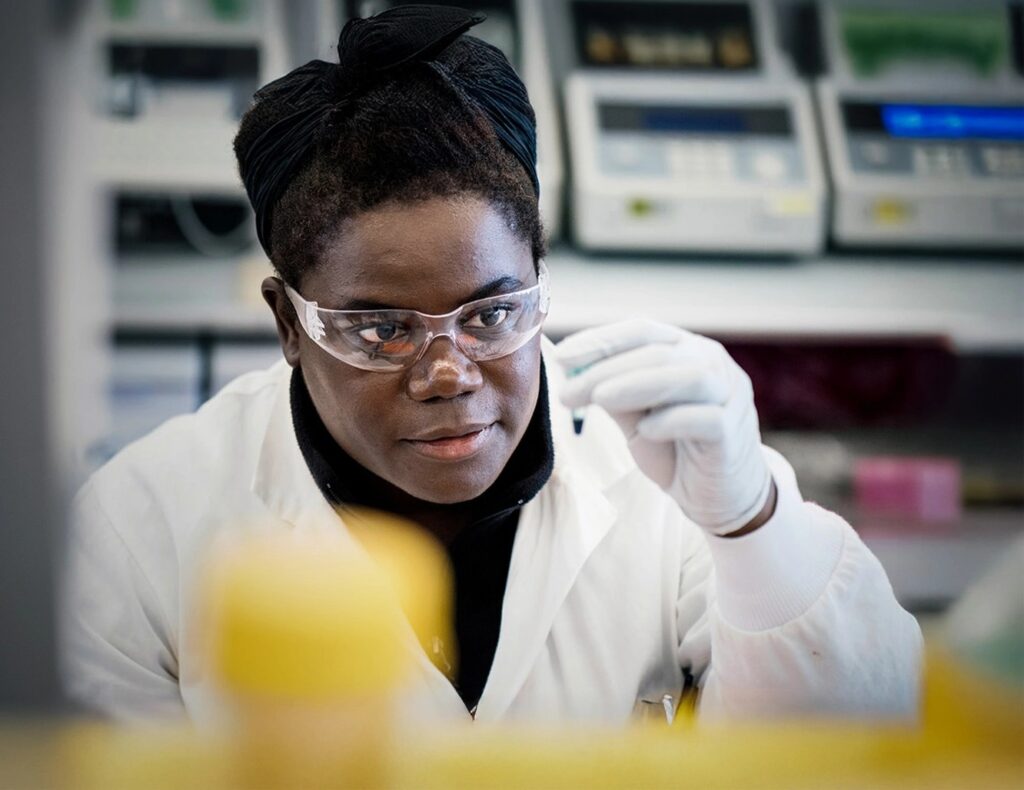Nearly a year after licensing Monte Rosa Therapeutics’ Phase II-bound autoimmune disease candidate MRT-6160, Novartis has agreed to partner on developing additional molecular glue degraders (MGDs) for immune-mediated diseases, in an expanded collaboration that could generate more than $5.7 billion for the Boston biotech.
Novartis plans to develop an unspecified number of degraders based on Monte Rosa’s artificial intelligence (AI) and machine learning (ML)-based Quantitative and Engineered Elimination of Neosubstrates (QuEEN™) discovery engine. QuEEN is designed to identify degradable protein targets and rationally design MGDs with what the company calls unprecedented selectivity, through the platform’s combination of AI-guided chemistry, diverse chemical libraries, structural biology, and proteomics.
In the second collaboration the companies have announced in 11 months, Novartis agreed to work with Monte Rosa on developing degraders for immune-mediated diseases targeting “highly credentialed” and difficult-to-drug targets.
Novartis also acquired an exclusive, royalty-bearing, sublicensable, and transferable license to an undisclosed discovery target and agreed to acquire options to license two programs from Monte Rosa’s preclinical immunology portfolio.
“This new agreement underscores our commitment to advancing targeted protein degradation as a promising approach to address immune-mediated diseases with high unmet need,” Fiona H. Marshall, PhD, Novartis’ president of biomedical research, said in a statement. “We believe Monte Rosa’s QuEEN™ platform has the potential to uncover new insights in this field. We look forward to working together to translate these insights into transformative therapies for patients.”
The latest Monte Rosa collaboration is Novartis’ fourth commitment of more than $1 billion announced this month alone. The pharma giant started September by inking an up-to-$2.2 billion partnership with Arrowhead Pharmaceuticals to license and develop Arrowhead’s preclinical small interfering RNA (siRNA) therapy ARO-SNCA, a potential treatment for Parkinson’s disease and other synucleinopathies, plus additional targets. Also this month, Novartis agreed to acquire Tourmaline Bio for $1.4 billion, and raised its potential payout to up-to-$5.2 billion in an expanded collaboration with Shanghai Argo Biopharmaceutical focused on cardiovascular disease candidates.
44% surge
Investors appeared to share Novartis’ enthusiasm for partnering with Monte Rosa, as shares of the Boston-based biotech leaped to $7.39 soon after the start of trading Monday before settling for a 44% surge, to $6.93 from Friday’s close of $4.81. Those shares sank two percent to $6.78 as of 10:35 AM ET. Novartis’ shares on the SIX Swiss Exchange dipped 1.2% to CHF 97.66 ($122.97) Monday and slipped another 0.6% to CHF 97.05 as of 10:17 AM ET Tuesday.
“We see this collab as a strong validation of GLUE’s molecular glue platform and a substantial non-dilutive capital at $400M cap to support multiple Ph2 readouts and many catalysts in the next 12 months,” Clara Dong, PhD, equity analyst with Jefferies, and three colleagues, wrote Monday in a research note, using the stock ticker symbol for Monte Rosa.
The latest collaboration follows the global exclusive license Novartis acquired in October 2024 to apply QuEEN toward developing T and B cell-modulating MGDs targeting the VAV1 protein, starting with Monte Rosa’s autoimmune disease candidate MRT-6160. Back then, Novartis agreed to pay Monte Rosa $150 million upfront, plus up to $2.1 billion in payments tied to achieving development, regulatory, and sales milestones, starting with the start of Phase II studies.
In the latest collaboration, according to a regulatory filing, Novartis agreed to pay Monte Rosa up to $5.7 billion, consisting of:
- $120 million upfront;
- Up to $60 million to maintain the options;
- Up to $180 million in preclinical milestone payments relating to the first licensed program plus option exercise payments;
- Up to $5.4 billion in payments tied to achieving clinical development, regulatory, and sales milestones relating to the first licensed program and two optioned immunology and inflammation (I&I) programs, to start upon the launch of Phase I studies; and tiered royalties on global net sales in the high single to low double-digit range.
The milestone payments would consist of up to $2.2 billion in potential development and regulatory milestone payments if regulatory approval is achieved for multiple indications in multiple territories; and up to $3.2 billion in potential sales milestones, to be allocated across licensed products.
‘Strong progress’
“We are extremely excited to extend our relationship with Novartis beyond our previously announced VAV1 agreement given the strong progress made to advance MRT-6160 toward initiation of multiple Phase II studies in immune-mediated diseases,” Monte Rosa’s CEO Markus Warmuth, MD, stated Monday.

“Our AI/ML-enabled QuEEN™ product engine continues to generate new insights and opportunities, delivering an expanding pipeline of programs directed against a breadth of historically undruggable immunology targets,” Warmuth said. “This new collaboration allows us to expedite the development of certain of those programs with Novartis, leveraging their recognized development and commercialization capabilities.”
Warmuth added that the latest collaboration with Novartis also benefits Monte Rosa by strengthening its financial runway beyond multiple anticipated Phase II data readouts for MRT-6160 as well as two other clinical-stage pipeline candidates. One is MRT-8102, an oral MGD that targets NEK7 to treat inflammatory diseases driven by IL-1β and the NLRP3 inflammasome. The other is MRT-2359, an MGD designed to treat castration resistant prostate cancer by inducing the interaction between the E3 ubiquitin ligase component cereblon (CRBN) and the translation termination factor GSPT1, leading to targeted degradation of GSPT1 protein.
In a presentation to investors, Monte Rosa trumpeted a “strong balance sheet providing cash runway into 2028”—the same timeframe it gave investors in reporting second quarter earnings in August—and added in a footnote that its characterization “does not reflect anticipated cash runway extension from payments associated with Novartis collaboration announced Sep[temper] 2025.”
Monte Rosa finished the second quarter with $295.5 million in cash, cash equivalents, restricted cash, and marketable securities as of June 30—down nearly 11% from $331 million as of March 31. Monte Rosa said it plans to update investors on its updated cash position and runway when it releases third quarter 2025 earnings.
According to Dong, the latest Novartis collaboration “could bring total cash to ~$380M by our est[imate], and provides runway beyond multiple Ph2 results.”

